Growing State Surveillance in New York City
The city has long been a testing ground for surveillance tools as a mechanism for social control.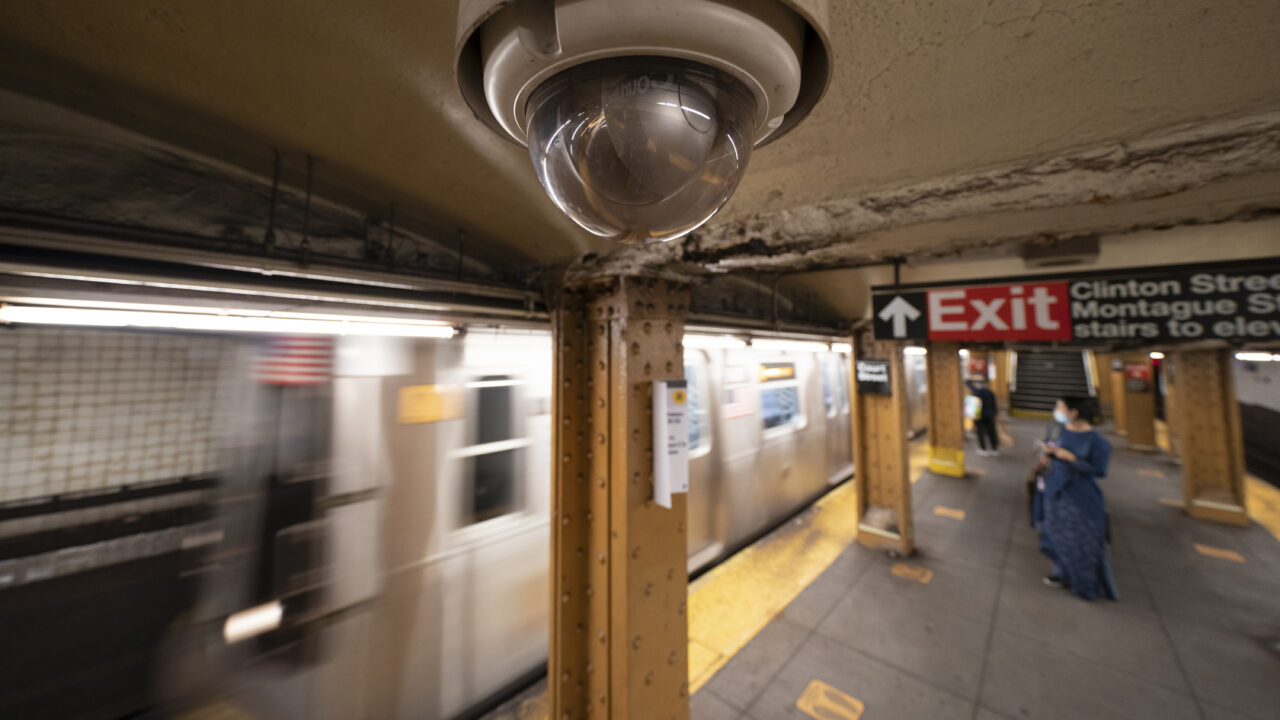 A video surveillance camera hangs from the ceiling above a subway platform in the Brooklyn borough of New York. Photo: Mark Lennihan / AP.
A video surveillance camera hangs from the ceiling above a subway platform in the Brooklyn borough of New York. Photo: Mark Lennihan / AP.
All over New York City, the deployment of surveillance technology is used as a crutch for safety and protection to obscure the real solution to societal problems: social welfare.
In March, the Metropolitan Transportation Authority (MTA) unveiled its newest subway cars and phased them into its A-train service, featuring the latest addition: surveillance cameras. In September 2022, Gov. Kathy Hochul announced that the MTA would install two surveillance cameras per train car to watch New Yorkers during their rides. During a press conference for the announcement, the governor weaponized law and order rhetoric to address moral panics concerning increased crime and violence in New York City subways.
“[W]e’re going to be having surveillance of activity on the subway trains, and that’s going to give people great ease of mind,” said Hochul. Later in the press conference, the governor seemed to preemptively dismiss concerns regarding the surveillance technology.
”If you’re concerned about this, the best answer is don’t commit any crimes on the subways, then you won’t have any problems,” Hochul said.
A 2021 Amnesty International investigation revealed that the New York City Police Department (NYPD) could track people throughout the city by running images from 15,280 surveillance cameras into “invasive and discriminatory” facial recognition software. The NYPD has used facial recognition technology in 22,000 cases since 2017, according to the report. Surveillance technologies enhance police power and allow covert policing to occur in our everyday lives. The NYPD can act as overseer, tracking New Yorkers as they move through the city.
As the largest and one of the most brutal occupying forces in the country, the NYPD is expanding its surveillance of New Yorkers.
As the largest and one of the most brutal occupying forces in the country, the NYPD is expanding its surveillance of New Yorkers. Last November, The Verge reported the NYPD’s partnership with Ring Neighbors, a neighborhood surveillance network that relies on Amazon’s Ring security cameras. Ring Neighbors uses facial recognition software and home security cameras to create a surveillance network via the Neighbors app that allows residents of a neighborhood to post safety information and footage from their cameras. While consumers use Amazon Ring devices for personal security use, the partnership between the NYPD and the tech company allows police to view posts on Neighbors and use Ring footage for criminal investigations.
The state has engineered carceral municipalities as a response to crises created by capitalism. According to scholar and poet Jackie Wang, these jurisdictions are extractive and over-policed spaces where indebtedness and “fugitivity” become an “existential condition forced on the people who reside in them.” Over the last 50 years, New York City has been a rehearsal space for the expansion of carcerality. By replicating prison surveillance and controlling human behavior, the growth of surveillance tech in the city constantly intrudes on the lives of the city’s most marginalized.
Surveillance technologies advance the work of racial capitalism and fascism by concealing the incursions of policing into our everyday lives. This makes it impossible for poor and working-class Black residents to exist privately and safely. Carcerality now dictates every aspect of U.S. cities and urban spaces, mirroring the function of the plantation and shaping the U.S. into what William C. Anderson describes as a “bordered execution chamber.”
The state has long used the politics of crime control and safety to justify new forms of social control to protect property and wealth. The proliferation of state-sponsored surveillance technologies is what author and scholar Shoshana Zuboff calls “surveillance capitalism.” This wholesale collection of our personal data by corporations for financial gain harms and immobilizes Black and brown people and is reminiscent of the surveillance practices used during enslavement to regulate Black life.
In many ways, New York City has also been a testing ground for surveillance tools as a mechanism for social control. UT Austin associate professor Simone Browne discussed lantern laws in her book “Dark Matters: On the Surveillance of Blackness,” detailing how 18th-century New York City mandated Black, mixed-race, and Indigenous enslaved people carry candle lanterns after dark. Today, Black and brown people still experience unequal amounts of surveillance and profiling. But now this surveillance happens through technology—and New Yorkers are fighting the intensifying surveillance ecosystem that encroaches on their everyday lives.
New Yorkers of color living in affordable and rent-stabilized developments experience the brunt of surveillance—and it’s not just an issue of race. These residents are impediments to the state’s ability to profit off of gentrification. Landlords then become deputized police. As co-founder of the Anti-Eviction Mapping Project, Erin McElroy wrote in a report, “Illegal sublet detection systems … reinforce anti-Black and plantation histories of landlordism in the U.S., in which landlords maintained policing power to ‘catch’ slaves and tenants breaking what had become white supremacist property law.”
New Yorkers of color living in affordable and rent-stabilized developments experience the brunt of surveillance—and it’s not just an issue of race.
In 2018, tenants of the rent-regulated Atlantic Plaza Towers in the gentrifying Brownsville, Brooklyn, neighborhood fought their landlord Robert Nelson’s effort to install facial recognition entry systems. Matching the larger gentrification of Brooklyn—which included the construction of luxury condominiums and the Barclays Center—Nelson planned to convert the rent-stabilized apartment complex into market-rate apartment units.
In an interview with Prism, Fabian Rogers, a constituent advocate for the office of state Sen. Jabari Brisport and a former resident of Atlantic Towers, explained that the ongoing changes to Atlantic Towers are meant to attract people interested in the “New York experience” and able to pay twice as much rent. Essentially, facial recognition systems entice gentrifying newcomers to the neighborhood.
The organization Housing and Community Renewal NYC informed Atlantic Tower residents that Nelson submitted two applications for the use of heat-mapping biometric interface technologies by the tech company StoneLock. At the time, StoneLock wasn’t used in residential buildings, and Atlantic Towers was going to be the first. Rogers said StoneLock was trying to test their tech on the tenants.
“It seemed like a scheme to help better the facial recognition algorithms at no cost because facial recognition is not great with Black and brown faces. These problematic ‘smart’ technologies are error-filled,” Rogers told Prism.
With the help of Brooklyn Legal Services, tenants organized as the Ocean Hill-Brownsville Alliance to stop Nelson’s surveillance tech plans. Tenants won this fight, but currently there is no legislation that protects tenants from the use of surveillance tech in their buildings, and Rogers said there is “no recourse to prevent this from happening again besides advocacy.”
Proptech or “landlord tech” raises privacy, racial profiling, and displacement concerns for tenants already vulnerable to such surveillance. Proptech companies cater to landlords (both public and private) to automate the management and maintenance of their housing rosters. This can range from keyless entry surveillance systems to tenant screening and property database platforms.
Technologies that foster social control are advancing to meet the state’s hunger for power, blurring the lines inside and outside prisons. In “Carceral Capitalism,” Jackie Wang describes how the tech industry influences financially strapped cities to contain residents’ reactions to austerity policies by using new technologies to enforce discipline and control. In effect, Wang says, this disguises the carceral state.
New partnerships between landlord technology companies, landlords, and developers incite racial profiling, augmented policing, automated evictions and fines, gentrification, and real estate speculation. And, in many Black and brown neighborhoods and public spaces, surveillance mirrors forms of penal control. New York City’s staunchly pro-police Mayor Eric Adams recently unveiled his “Omnipresence” police plan to remove houseless people from subways and added another NYPD-enforced policy to forcibly hospitalize houseless people deemed to be in “psychiatric crisis.”
Despite growing opposition to the extensive camera and facial recognition surveillance, Mayor Adams has pledged to bolster the use of police and technology.
In 2014, as part of the NYPD’s Omnipresence program with the New York City Housing Authority (NYCHA), housing projects in the city’s most policed and neglected neighborhoods are forced to live with the glare of massive floodlights marked with NYPD insignias, parked police cars on sidewalks, and beat cops watching their every move. As John Surico wrote in Vice, “Eyes, ears, and lights are now on every corner.” Now many of these neighborhoods are policied in less visibly harmful ways.
Despite growing opposition to the extensive camera and facial recognition surveillance, Mayor Adams has pledged to bolster the use of police and technology. As political leaders and corporate-owned media outlets continue to fearmonger and push for increased surveillance in Democratic-led cities, privacy advocates, abolitionists, and activists against police violence are banding together to create an anti-surveillance movement that exposes the fallacies around public safety and surveillance.
“It feels like you are constantly being watched,” Rogers said. “[Authorities] always over-surveilling and under-protecting—especially in affordable housing-based neighborhoods. I’ve never felt relaxed in New York.”
Your support matters…Independent journalism is under threat and overshadowed by heavily funded mainstream media.
You can help level the playing field. Become a member.
Your tax-deductible contribution keeps us digging beneath the headlines to give you thought-provoking, investigative reporting and analysis that unearths what's really happening- without compromise.
Give today to support our courageous, independent journalists.
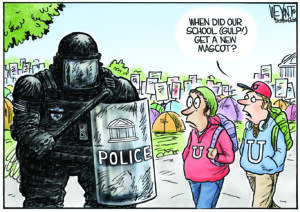
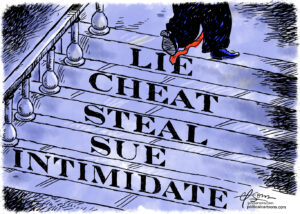

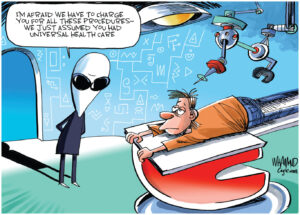
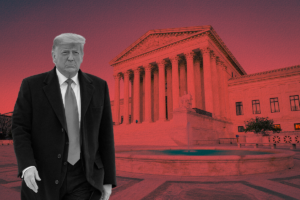

You need to be a supporter to comment.
There are currently no responses to this article.
Be the first to respond.